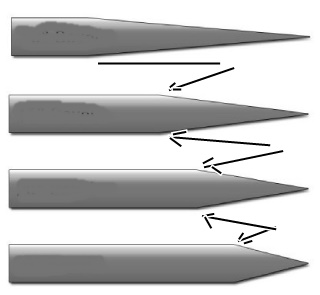New member, first post. This has been my go to site for knife info for years and finally decided I should join.
I have been sharpening with the Lansky guided system for over 30 years cuz I can't sharpen freehand, I just can't. I have knives to prove it.
OK on to the topic. I get a burr at the top of my secondary bevel where it meets the primary grind. Am I the only person in the world this happens to? I have searched the internet countless times looking for this issue and found nothing. It is easy to remove this burr but I can't believe nobody has mentioned it, ever, anywhere. So much good info out there for newbie and experienced sharpeners. So much discussion of edge burrs but nothing about a burr at the top of the secondary bevel.
This burr frequently (for me) manifests itself as a sort of bump or step or ledge but can also be a true wire type burr. I think it depends on blade steel, sharpening pressure, the difference between the primary and secondary angles, phases of the moon, who knows.
Freehand sharpening may not produce this burr due to the slightly inconsistent sharpening angle inherent with that method but if you use a guided system and are sharpening the entire face of the secondary bevel then this must be happening to someone besides me unless the laws of physics are different in my world.
This burr is real and can affect the cutting ability of the knife. Think mirror polished edge and then put a little wall at the top of your edge bevel. Not so good for slicing. Not trying to be controversial or start any arguments, just wondering why nobody mentions this.
I have been sharpening with the Lansky guided system for over 30 years cuz I can't sharpen freehand, I just can't. I have knives to prove it.
OK on to the topic. I get a burr at the top of my secondary bevel where it meets the primary grind. Am I the only person in the world this happens to? I have searched the internet countless times looking for this issue and found nothing. It is easy to remove this burr but I can't believe nobody has mentioned it, ever, anywhere. So much good info out there for newbie and experienced sharpeners. So much discussion of edge burrs but nothing about a burr at the top of the secondary bevel.
This burr frequently (for me) manifests itself as a sort of bump or step or ledge but can also be a true wire type burr. I think it depends on blade steel, sharpening pressure, the difference between the primary and secondary angles, phases of the moon, who knows.
Freehand sharpening may not produce this burr due to the slightly inconsistent sharpening angle inherent with that method but if you use a guided system and are sharpening the entire face of the secondary bevel then this must be happening to someone besides me unless the laws of physics are different in my world.
This burr is real and can affect the cutting ability of the knife. Think mirror polished edge and then put a little wall at the top of your edge bevel. Not so good for slicing. Not trying to be controversial or start any arguments, just wondering why nobody mentions this.


